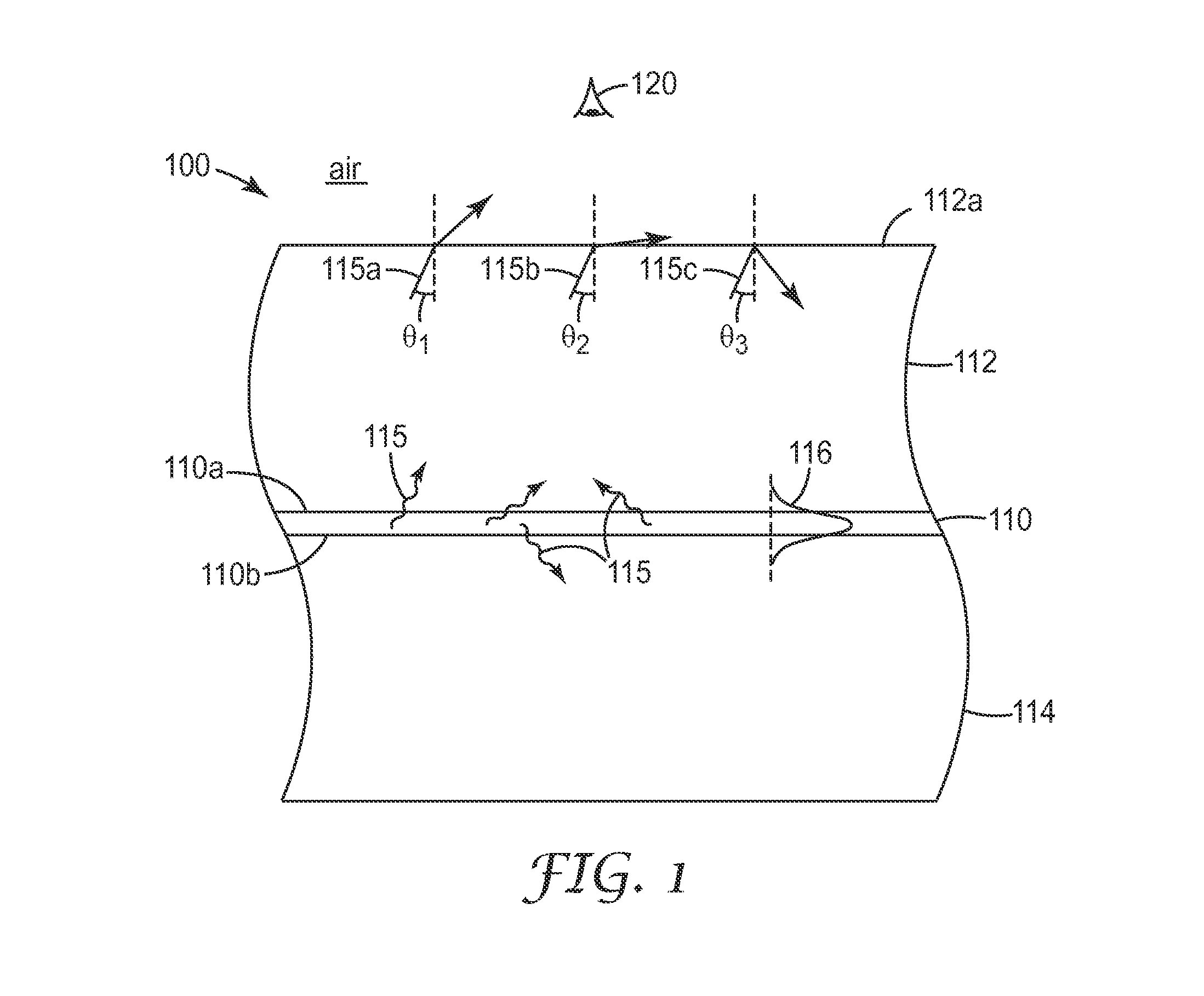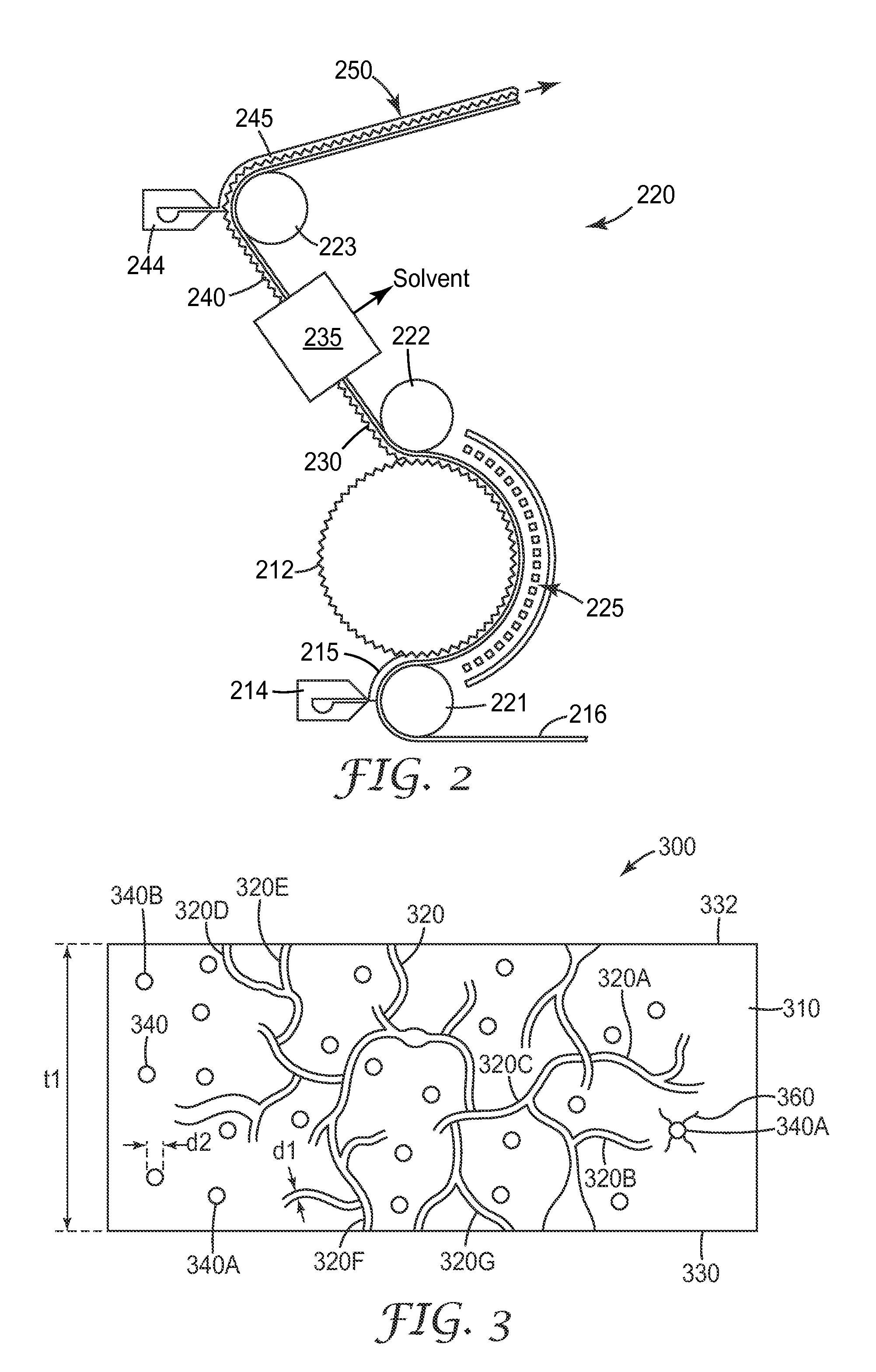Light Extraction Films for Increasing Pixelated OLED Output with Reduced Blur
- Summary
- Abstract
- Description
- Claims
- Application Information
AI Technical Summary
Benefits of technology
Problems solved by technology
Method used
Image
Examples
example 1
50 / 60 Bullet-Shaped Extractors, Adhesive Backfill, No Haze in ULI
[0114]A computer simulation was performed of an OLED with an embedded extraction layer using ray tracing methods and the modeling package LIGHTTOOLS (commercially available from Optical Research Associates, Pasadena, Calif.). The configuration that was simulated is shown generally as OLED device 520 in FIG. 5. The microreplicated nanovoided material of Ultra Low Index (ULI) (see e.g. layer 414 in FIG. 5) was modeled as having a refractive index of 1.2 and zero haze. The refractive index of the carrier film or substrate (see e.g. layer 412 in FIG. 5) was selected to be 1.65 to model a polyethylene terephthalate (PET) substrate. The refractive index of the backfill layer (see e.g. layer 416 of FIG. 5) was selected to be 1.48 to model Soken 2032 pressure sensitive adhesive (commercially available from Soken Chemical & Engineering Co., Ltd, Japan). The substrate was assumed to have a thickness of 100 μm.
[0115]The extractio...
example 2
50 / 60 Bullet-Shaped Extractors, Adhesive Backfill, Haze in ULI
[0117]An OLED with an optical extraction film was simulated in the same way as in Example 1, except that some haze was included in the nanovoided Ultra Low Index (ULI) layer. This was simulated by adding scattering centers to the simulated nanovoided layer, where the scattering centers scattered light primarily in the forward 45° cone angle, and with a scattering probability set at 20% (i.e., the probability for a light ray to be scattered at least once upon traveling through the layer was set to 20%). With this built-in haze in the nanovoided layer of the simulated extraction film, the angular color non-uniformity was reduced to 0.010, and the integral gain was improved to 1.51.
example 3
50 / 60 Bullet-Shaped Extractors, HRI Backfill, No Haze in ULI
[0118]An OLED with an optical extraction film was simulated in the same way as in Example 1, except that the refractive index of the nanovoided ULI material was set to 1.26 (rather than 1.2), and the refractive index of the backfill material (see e.g. layer 416 in FIG. 5) was chosen to be 1.65 (rather than 1.48) which is representative of a high refractive index curable resin such as a nanozirconia-filled UV curable acrylate resin, such as those described in U.S. Pat. No. 7,547,476 (Jones et al.).
[0119]The color non-uniformity and integral gain were determined as in Example 1. The calculated color deviation is given in Table 2. The maximum angular color non-uniformity with and without the optical extraction film was 0.0083 and 0.0242, respectively. The integral gain with the extraction film was 1.55.
TABLE 2Δu′v′AngleOLED withΔu′v′(degrees)Extraction FilmOriginal OLED88.50.00220.024285.50.00300.021982.50.00530.020279.50.0083...
PUM
| Property | Measurement | Unit |
|---|---|---|
| Length | aaaaa | aaaaa |
| Thickness | aaaaa | aaaaa |
| Thickness | aaaaa | aaaaa |
Abstract
Description
Claims
Application Information
 Login to View More
Login to View More - R&D
- Intellectual Property
- Life Sciences
- Materials
- Tech Scout
- Unparalleled Data Quality
- Higher Quality Content
- 60% Fewer Hallucinations
Browse by: Latest US Patents, China's latest patents, Technical Efficacy Thesaurus, Application Domain, Technology Topic, Popular Technical Reports.
© 2025 PatSnap. All rights reserved.Legal|Privacy policy|Modern Slavery Act Transparency Statement|Sitemap|About US| Contact US: help@patsnap.com



